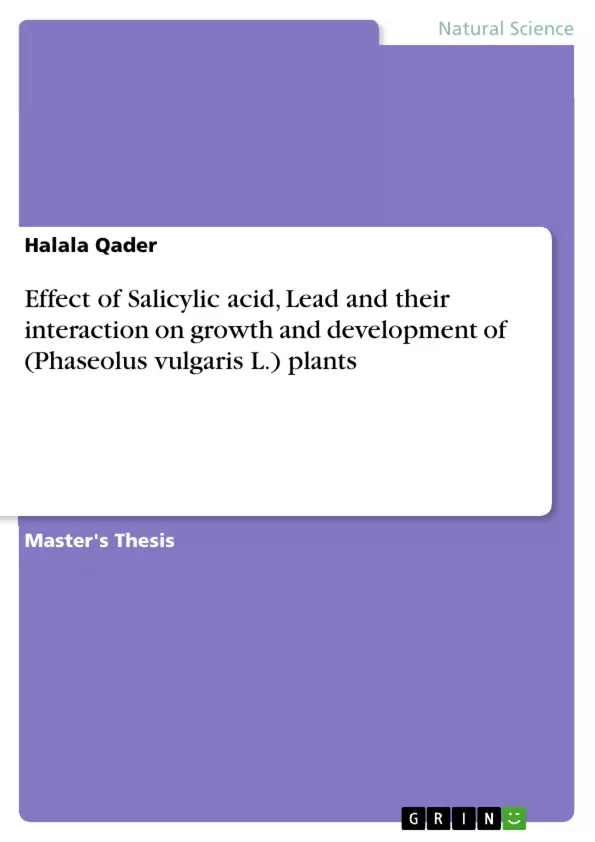This study consisted of four experiments conducted in the greenhouse of Biology Department in the College of Science- University of Salahaddin- Erbil, during 18/4/ 2012 to 28/7/2012. The first experiment consisted of foliar spray of different concentrations of Salicylic acid (0, 50, 100, 200 and 400ppm), the second experiment included the application of different methods of Salicylic acid (250ppm) (presoaking seeds, foliar spray, injection, and soil application). The third experiment consisted of different concentrations of Lead (0, 5, 10, 15 and 20ppm) as soil irrigation, and the fourth experiment consisted of interaction application of Salicylic acid and Lead on vegetative growth, yield and chemical components of common bean. The results obtained were analyzed statistically using Complete Randomized Design (C.R.D) for the first three experiments and Factorial Complete Randomized Design (Factorial C.R.D) for the fourth experiment, with four replications for each treatment. Comparison of means were carried out by using Duncan’s Multiple Range Test at the probability of (0.05) for vegetative and yield parameters and (0.01) for the chemical constituents.
Inhaltsverzeichnis (Table of Contents)
- Summary
- Introduction
- Literature review
- Materials and methods
- Plant material
- Chemicals
- Experimental design and treatments
- First experiment
- Second experiment
- Third experiment
- Fourth experiment
- Growth parameters and analysis
- Chemical analysis
- Statistical analysis
- Results and discussion
- Effect of Salicylic acid
- First experiment
- Second experiment
- Effect of Lead
- Interaction of Salicylic acid and Lead
- Conclusion
- References
Zielsetzung und Themenschwerpunkte (Objectives and Key Themes)
This research investigated the impact of salicylic acid and lead, both individually and in combination, on the growth, development, and chemical composition of common bean plants. The study aimed to determine optimal application methods and concentrations of salicylic acid for enhancing bean plant growth and yield, while also examining the effects of lead toxicity and potential mitigation strategies.- The influence of salicylic acid on vegetative growth, yield, and chemical components of common bean plants.
- The effects of lead contamination on bean plant growth and yield.
- The potential for salicylic acid to mitigate the negative impacts of lead stress on bean plants.
- The optimization of salicylic acid application methods for maximizing its beneficial effects.
- The elucidation of the underlying mechanisms by which salicylic acid and lead affect bean plant physiology.
Zusammenfassung der Kapitel (Chapter Summaries)
The research was divided into four experiments conducted in a greenhouse setting. The first experiment focused on the effects of different concentrations of foliar-applied salicylic acid on bean plant growth and yield. The second experiment investigated the efficacy of various application methods for salicylic acid, including presoaking seeds, foliar spray, injection, and soil application. The third experiment examined the impact of different concentrations of lead in soil irrigation on bean plant growth and yield. Finally, the fourth experiment explored the interactive effects of salicylic acid and lead on bean plant growth, yield, and chemical composition.Schlüsselwörter (Keywords)
This study focused on the application of salicylic acid and lead, examining their impact on the growth, development, and chemical composition of common bean plants. Key themes include plant stress tolerance, heavy metal contamination, plant growth regulators, agricultural productivity, and chemical analysis of plant tissues.- Citar trabajo
- Halala Qader (Autor), 2013, Effect of Salicylic acid, Lead and their interaction on growth and development of (Phaseolus vulgaris L.) plants, Múnich, GRIN Verlag, https://www.grin.com/document/282593



